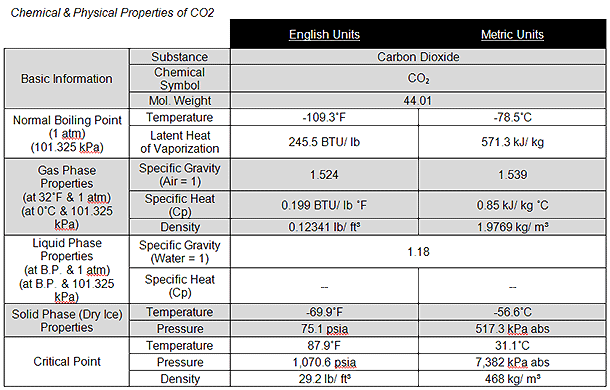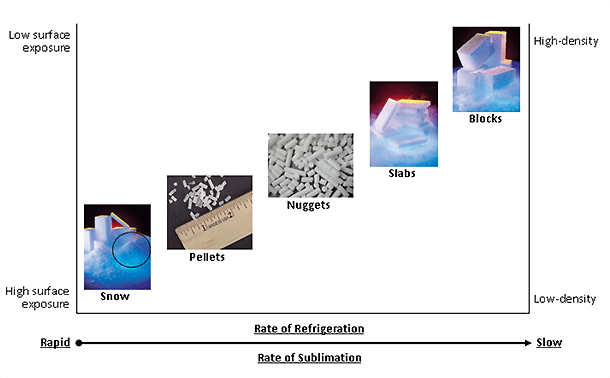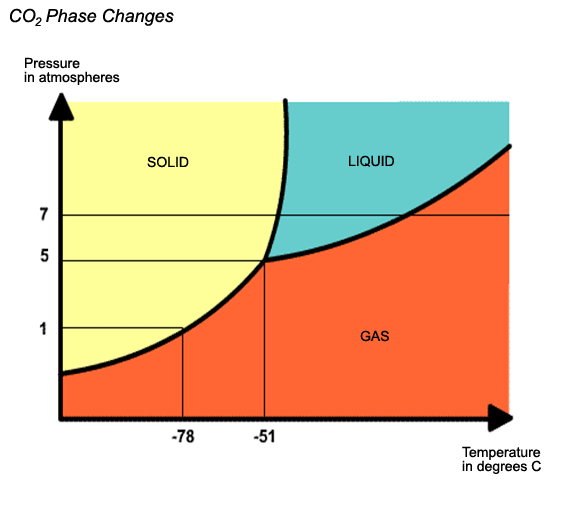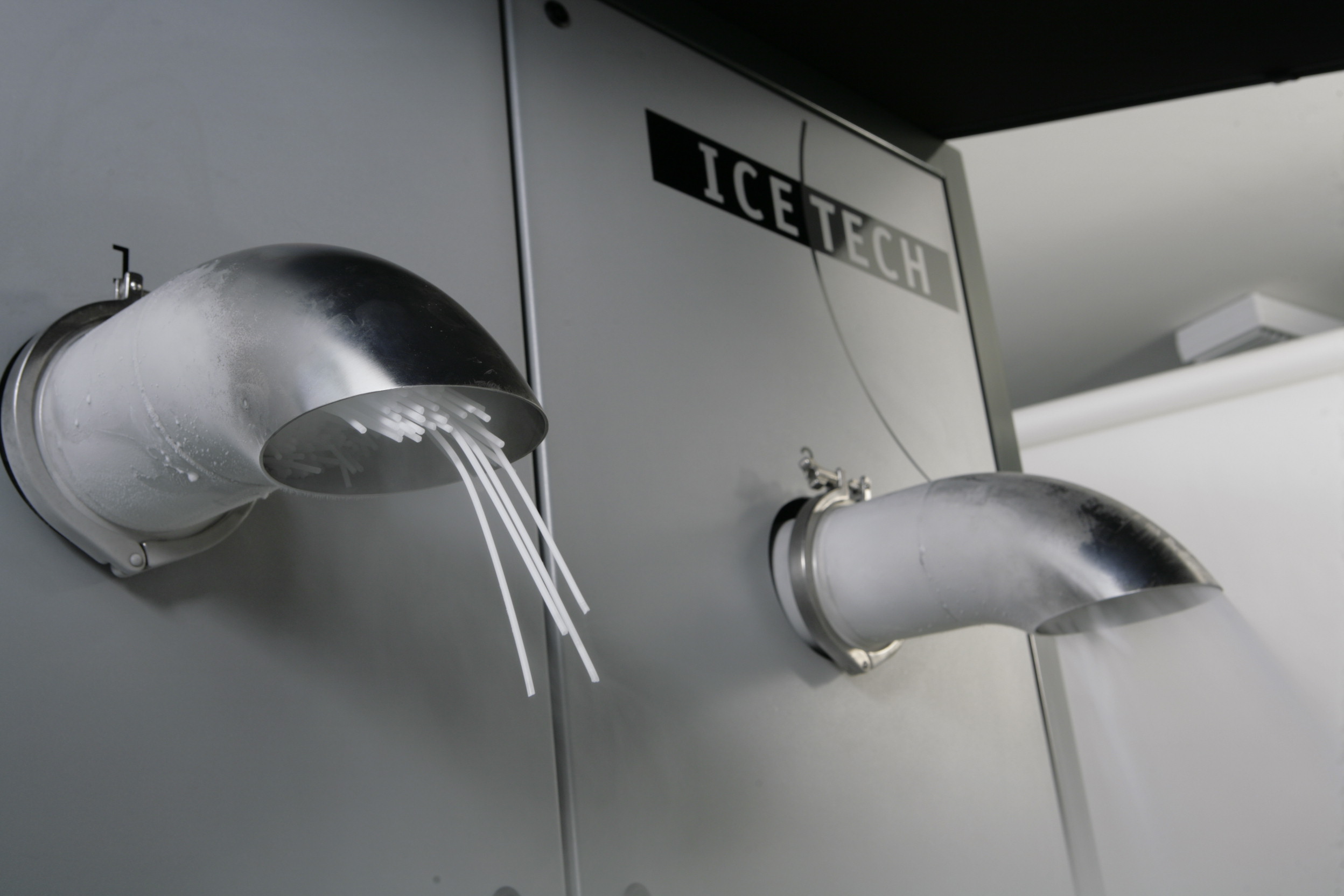All About Dry Ice
Dry ice is solid CO2 with a low temperature of -78° C (-109° F). At atmospheric pressure, solid CO2 sublimates directly to vapor without a liquid phase. This unique property means that the dry ice simply "disappears" when it heats up, leaving no residue or waste to be cleaned.
The CO2 used to make dry ice is a natural by-product of several industrial manufacturing processes such as fermentation and petrochemical refining. The CO2 given off by the above production processes is captured and stored without losses until needed. When dry ice is used no new CO2 is produced. Instead, only the original CO2 by-product is released which is why using dry ice is considered to be "carbon-neutral" and environmentally responsible.
CO2 Properties
Carbon dioxide (Chemical Symbol = CO2) is a natural byproduct of respiration, fermentation, and other industrial processes, existing as a colorless, odorless, and non-flammable gas. Its density at 25°C is 1.98 kg/m3 (0.123 lbs/ft3 at 32°F), about 1.65 times that of air, which means that CO2 gas displaces oxygen in the environment (CO2 sinks below oxygen).
Dry ice is the solid form of CO2 and is white opaque in appearance. It is important to handle or store CO2, whether solid or gas, in well-ventilated areas to reduce the danger of asphyxiation.
The detailed table below shows the chemical and physical properties of CO2.

Dry ice sublimates or changes directly from solid to gas, without a liquid phase. The rate of sublimation must be taken into account when packing a container system since it gets smaller in size. Dry ice sublimates at a rate of 3% to 8% per day, depending on the thermal properties of the container and external temperature profile. One pound of dry ice will sublimate into 8.3 cu. ft. of carbon dioxide gas.
Slabs of dry ice last longer than pelletized dry ice, which sublimates faster.
* Scale in image below is for illustrative purposes only

Dry Ice Types
 Snow |
 Pellet |
 Nugget |
 Slab |
 Block |
|
|---|---|---|---|---|---|
| Description | Dry ice snow looks like water snow and has a very high sublimation rate compared to pellets, nuggets, slabs, and blocks. Dry ice snow requires less complex equipment to produce; however, it has a very short shelf life. | Dry ice pellets look like rice (3mm or 1/8") and are mainly used for dry ice blasting. Due to the pellets' lower sublimation rate and smaller size than dry ice snow, the use of pellets to freeze food for food processors has recently become more common. | With sizes ranging from 6 mm (1⁄4") to 19 mm (3⁄4") in diameter, dry ice nuggets are typically used for packaging and shipping food and product materials. | Dry ice slices or slabs are predominantly used by the airline catering industry because the typical slice size of 19 mm (3/4") fits nicely in catering carts. Some companies use slices for shipping. | Dry ice blocks have historically been made to keep packaged and shipped items cold for a long period of time. Today, dry ice blocks can also be utilized for dry ice blasting (Cold Jet patented block-shaver technology). Standard block sizes vary from country to continent. |
| Size | n/a | 1 to 3 mm | 6-19 mm | Standard size = 210 x 125 x 18 mm | Standard size = 250 x 250 x 125 mm |
| Sublimation Rate |
|
|
|
|
|
| Applications |
|
|
|
|
|
| Primary Users |
|
|
|
|
|
Deposition, Sublimation & Rate of Refrigeration
Dry ice undergoes the process of deposition or sublimation at the critical temperature of −78°C (-109.3°F). As CO2 reaches temperatures below −78°C, it transitions directly from a gaseous to a solid state (i.e. dry ice forms) in a process called deposition. In contrast, as CO2 reaches temperatures above −78°C, it transitions directly from a solid to gaseous state (i.e. dry ice disappears into CO2 gas) in a process called sublimation. During the processes of deposition and sublimation, dry ice never reaches a liquid phase; thus, there is no residue or water waste associated with dry ice.

Note About High-Density Pellets


High-density pellets are created using specialized extrusion dies and pelletizers that produce a consistent quality CO2 pellet as opposed to the more common pellets produced from compacted dry ice snow. While the sublimation rate remains the same for both high-density and regular dry ice, high-density ice will take longer to completely sublimate since there is more dry ice per square inch.
High-density dry ice has:
- improved transportability
- longer shelf life
- increased aggression for blasting applications
DRY ICE PRODUCTION
- All About Dry Ice
Learn about dry ice. - Making & Handling
See how dry ice is made. - Making vs Buying
Should you make or buy the dry ice you use? Find out here. - Dry Ice for Cleaning
See how dry ice is used for industrial cleaning. - Dry Ice for Packaging
Using dry ice for packaging and shipping. - Dry Ice for Processing
See how dry ice is being used in the processing and manufacturing industries. - Buy Dry Ice
Contact Cold Jet to find a dry ice supplier near you.





